Fall 2019 Illinois Space Day Is Out of This World
 An Illinois Aerospace Engineering student interacts with a young Franklin School student building a space vehicle with Legos.
An Illinois Aerospace Engineering student interacts with a young Franklin School student building a space vehicle with Legos.October 18, 2019
Would you like to blast off on a rocket ship some day to explore outer space? Doubtless some of the around 200 people who showed up for Illinois Space Day (ISD) on October 5th would. Among the 150+ visitors to the event at the Digital Computing Lab were some local teachers, parents, and lots of K–8th grade students—possibly with some future aerospace engineers or maybe even an astronaut or two among them. Also on hand were numerous Illinois Aerospace Engineering students, sporting t-shirts emblazoned with “The 50th anniversary of the Moon Landing!” to celebrate one of Man's most important forrays into space and the theme of the Day: the Apollo 11 mission. The Aerospace students’ goal in participating in the event was to not just share their passion for space with the young visitors, but also to possibly recruit some into aerospace engineering down the road, or to help pique the interest of a future astronaut.
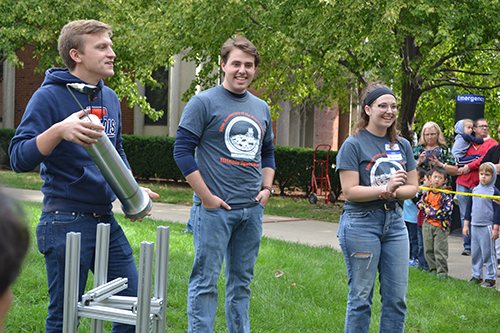 Aerospace Engineering students prepare to test a hybrid engine.
Aerospace Engineering students prepare to test a hybrid engine.Organized by the Illinois Space Society (ISS), Illinois Space Day, the society's biggest educational outreach event of the year, was run by volunteers from a number of Aerospace Engineering RSOs (Registered Student Organizations). In addition to around 55 members of ISS, the sponsoring organization, members of other groups, including Illinois Robotics in Space (IRIS), Women in Aerospace, to name a few, also helped out at the event.
The event lasted from about 8:30am to 3:30pm. For the first half of the day, visitors rotated through a variety of exhibits. They learned about rockets and saw some that have actually flown. They learned about how earth's weather can be used to predict the weather on other planets. They experienced the always-popular liquid nitrogen demos, where flowers were flash frozen then shattered, and where a balloon immersed in liquid nitrogen would shrivel up, then regain its previous size when exposed to room temperature air once again. Of course, the highlight of that exhibit was getting to eat marshmallows flash frozen in liquid nitrogen. Visitors enjoyed the smoke and noise of hybrid fuel demos. The young students also contributed artwork to a “Space Wall,” built rockets or space ships with Legos, and learned about orbits then found out what they looked like by rolling marbles down into an orbit simulator.
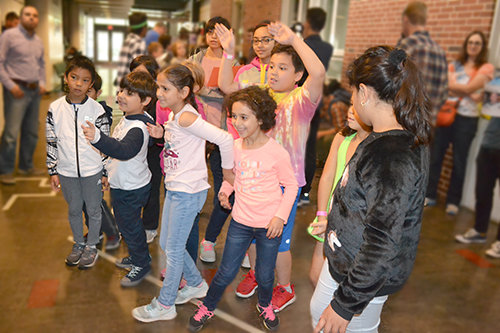 Illinois Space Day visitors looking at themselves via a depth camera .
Illinois Space Day visitors looking at themselves via a depth camera .Young visitors also appreciated "seeing" themselves courtesy of a depth camera, one activity presented by members of Illinois Robotics in Space. Other activities members of the club presented included exposing youngsters to how 3D printing works, and all about sensors on a robot. One IRS exhibit also featured a moon rover, which, sadly, they couldn’t demonstrate. “So we can't run that right now,” one IRS member explained. “It's too big, and it'll rip up the floor.” In addition to the rover, which astronauts can drive, robots in space do other important activities, such as digging and excavation, sensing, and localization.
Another popular exhibit was balloon races. There two youngsters would tie their balloons to lines then release them to see how fast they would travel as their balloons deflated and if they could beat each other.
According to Zana Essmyer and Alonzo Arostegui, their exhibit demonstrated how weather patterns on earth can be used to simulate weather patterns on other planets. Essmyer reported that she participated in space day because she’s really interested in educational outreach. “I'm the ED director for Women in Aerospace,” she said, “and I think it's really important to get young kids interested in STEM."
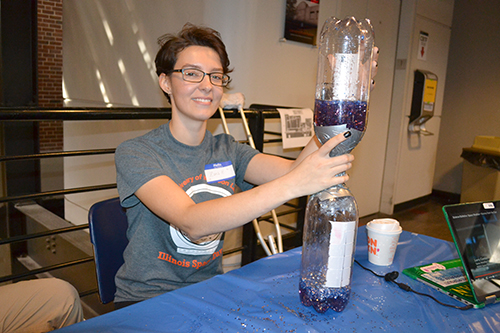 Zana Essmyer does a demo to show how earth's weather patterns can simulate weather on other planets.
Zana Essmyer does a demo to show how earth's weather patterns can simulate weather on other planets.What impact did Space Day seem to be having on the kids? “So far it's pretty good,” she said. “They seem really excited. They've been answering a lot of questions and asking us things. So, I think it's going pretty well.”
Arostegui explained why he got involved, “I've always had an incredibly deep and personal interest in space and what happens in the universe,” he says. “So, I kind of wanted to have a moment to express that to other people, because I love sharing something I love with others and trying to get them involved with it. And I think that getting people involved in space and astronomy is really important right now.
During lunch, a student panel comprised of a number of Aerospace students answered questions which ranged from what being an Aerospace student was like to questions about space and/or space travel.
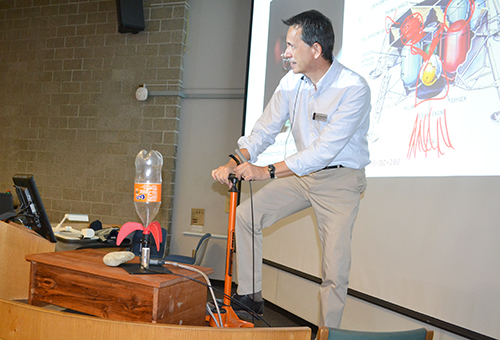 Leon Liebenberg prepares to launch a bottle rocket during his presentation.
Leon Liebenberg prepares to launch a bottle rocket during his presentation.Following lunch was the guest speaker, Mechanical Science and Engineering Professor Leon Liebenberg. Having had him for courses, the students who planned the event knew how fun and entertaining he was, and thus had invited him to speak. Part of Liebenberg’s strategy to engage the young visitors was to encourage them to help with his presentation. So he’d question them about space and space travel then have them share their responses into a roving microphone. Of course, he wowed the audience by climbing up on top of the desk and using a bicycle pump to launch a bottle rocket.
The last event of the day was the egg drop engineering challenge. After building the best egg drop lander they could, the teams of students trooped up to the third floor and, after ensconcing an egg in their contrivance, they dropped it, aiming at the bullseye three stories below, then breathlessly waited to see if their egg had survived intact, or would splatter on the floor below.
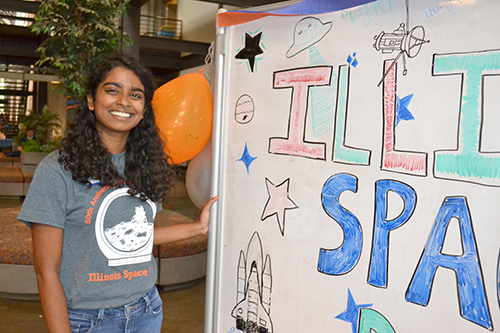 ISS Outreach Coordinator Shivani Ganesh
ISS Outreach Coordinator Shivani Ganesh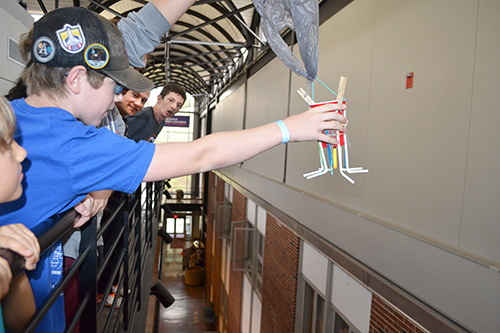 Brandon Roady, a Mahomet Seymour 7th grader, prepares to test his team's egg drop lander.
Brandon Roady, a Mahomet Seymour 7th grader, prepares to test his team's egg drop lander.
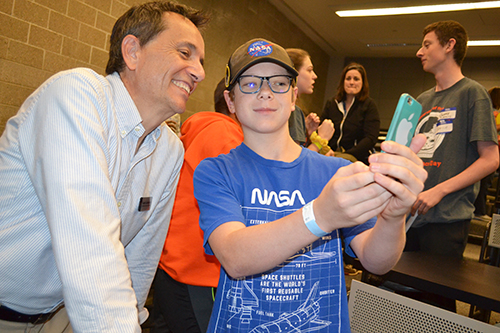 Brandon Roady (right), takes a selfie with guest speaker Leon Liebenberg after his presentation.
Brandon Roady (right), takes a selfie with guest speaker Leon Liebenberg after his presentation.Why host a day celebrating space? According to the ISS Outreach Coordinator, Aerospace Engineering junior Shivani Ganesh, the goal of Illinois Space Day is the same as it's always been. “It's providing a very accessible and exceptionally fun way to learn about aerospace, and offering that opportunity out to the community.”
Having chatted with other ISD volunteers on why they're part of the event and why they've put so much work into it, she indicated, “It's that they never had these opportunities as they were growing up. They had to seek it out on their own. So giving the opportunity to kids from a very young age is super important,” she stated. She added that making the event accessible to everyone, and free to the public is also important to them. “We want to keep it that way to make sure that anybody who wants to learn aerospace has that outlet to do so.”
The president of Illinois Robotics in Space, Victoria Jiron, explained that while participating in various competitions is important to IRS members, another important activity is outreach. “We find it really important to spread the word of robotics and encourage little kids to look at all of the different parts,” she says. “So even if they're not into robotics, there's art in it and building and every aspect. So outreach is very important to us.”
What kind of impact did the event have on the kids? For one, they found out a lot more about space. For example, sporting a NASA t-shirt (which probably pretty much says it all regarding his career aspirations), was Mahomet Seymour seventh grader Brandon Roady. One of the stars of the show during Leon Liebenberg’s presentation (other than the man himself!), Roady asked thoughtful, knowledgeable questions and gave well-informed answers about space and space travel, probably putting half of the adults in the room to shame (including this writer.)
In response to the query, “So you love space, huh?” he responded: “Yeah, quite a bit.” What had he done to find out so much about space? “I just like to read a lot on the internet,” he responded. “Like NASA.” Then to prove that he visits the site frequently, he rattled off the url: “www.nasa.gov.”
Roady dreams big when it comes to what he wants to do when he grows up; one possibility is, of course, NASA. “I want to either work at NASA, at the head of aerospace engineering for propulsion,” he shared, “or have my own company, Roady Aerospace, and just launch little satellites like the company Rocket Lab does with the electron.”
The seventh grader, who plans to go into aerospace and become an engineer, said he’ll most likely matriculate to Illinois: “If I don't move,” he qualified, then added, “I've heard that this is one of the top aerospace engineering programs.”
Roady’s favorite thing about Illinois Space Day was Liebenberg’s presentation. “Probably the lecture that we just had,” he acknowledged, “just learning all that stuff about space and what we can do to make it better.” Most likely he also enjoyed the chat he had with Liebenberg afterwards, who hung around after his presentation just to encourage the youngster.
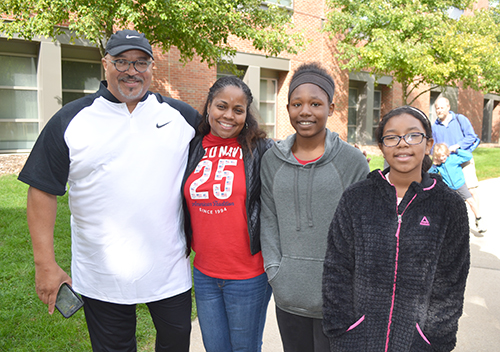 Dave Anderson, his fiancé Nikki Moore, and their two kids.
Dave Anderson, his fiancé Nikki Moore, and their two kids.One family who showed up at Space Day was Dave Anderson, a professional photographer, his fiancé Nikki Moore, a teacher, and their two kids. Regarding the impact the day was having on all her students, Moore, who teaches 4th/5th grades, reported: “They're actually learning a lot. I can tell which stations have been their favorite: The orbits simulator and the Legos, so far, have been their favorite, ‘cause they get to do things hands-on.” Did she see any astronauts or aeronautical engineers in her group? “Yes, she replied: “I got a couple already.”
Another family who brought their kids to ISD were Abby and Barry Houser from Mahomet. Abby says they heard about space day from a flyer that came home from school with the kids, who are in first and second grade. After checking it out online, she explained, “It looked pretty cool. They said it was free; they feed you lunch; and that it's appropriate for K through fifth or sixth grade. We didn't have any plans, so we were down for it.”
Abby thought her kids’ favorite activity so far was the dry ice marshmallows. Evidently Mom enjoyed that too. “Yeah, that was very cool to feel the freezing cold marshmallow with the gooey inside still. They really liked that.”
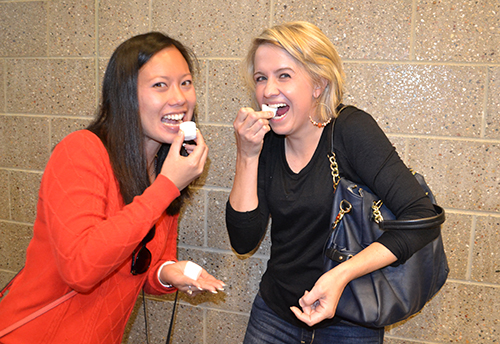 Abby Houser (right), and another intrepid soul valiantly agree to be photographed while chomping on their liquid-oxygen-frozen marshmallows.
Abby Houser (right), and another intrepid soul valiantly agree to be photographed while chomping on their liquid-oxygen-frozen marshmallows.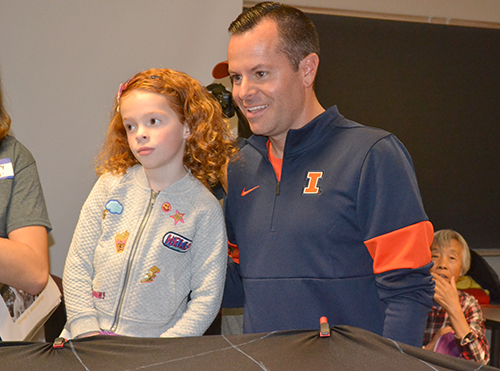 Barry Houser and his daughter learn about orbits and prepare to toss marbles into the Orbit Simulator.
Barry Houser and his daughter learn about orbits and prepare to toss marbles into the Orbit Simulator.Abby shared why it’s important to bring kids to events like ISD. “You know, I think that exposure is the most important part of any of it,” she admitted, “even though they might not know how rocket fuel engines work, and different things. But to expose them to different things that they might take interest in and be passionate about, I think is the most important part.”
When his wife found out what a great event ISD was, Abby’s husband Barry Houser was excited because he had the day off, and that meant he could go with them. (Most Saturdays he has to work. Houser is the director of the Marching Illini, so lots of Saturdays he’s out on the football field, putting his band through its paces.)
Houser was also delighted to attend because a number of his Marching Illini were at ISD too, helping to put on the program. “So it was a great opportunity to bring our own kids to this great event,” he said, “And, you know, it's dealing with space, so tons of excitement about what's going on here and all the exhibits.”
So, music or aerospace engineering? Which one is he going to steer his kids toward? “Well, you know, it's amazing,” he admitted. “So, even with the Marching Illini, we've got a hundred of our students that are a part of engineering.”
In other words, his kids wouldn’t necessarily have to choose between music and a career in, say, aerospace engineering. Houser says they could actually do both.
“Yeah, so you can do both,” he affirmed. In fact engineering is one of the largest majors that they have in the band. “So it's interesting to see that so many of them have some type of musical training and then they go in this field. And so we're of course very proud of that. “
An advocate for both STEM and the arts, Houser added, “So of course, we'll call that STEAM then, cause we're going to go with STEM and adding the arts to that. And we just continue to find that there's a tremendous pairing between some of these natural studies that are here.”
Regarding students who have some type of arts background and training in addition to STEM, Houser adds, “We look at those as going hand in hand, and what that can do to just make a well-rounded person, and how they can contribute to society in such a wonderful way.”
Story and photos by Betsy Innes, Communications Specialist, I-STEM Education Initiative.
For more articles about Illinois Space Society, please see:
- Illinois Space Day Exposes Young Visitors to "Space, the Final Frontier..."
- Illinois Space Society Provides Members Stellar Technical and Leadership Experiences to Prepare Them for Careers in Space Technology
More: Aerospace Engineering, Undergrad, 2019
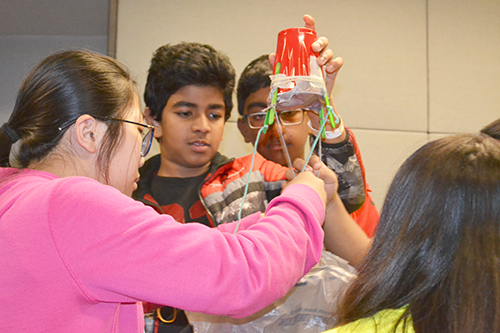 ISD participants prepare their egg drop lander for the competition.
ISD participants prepare their egg drop lander for the competition. 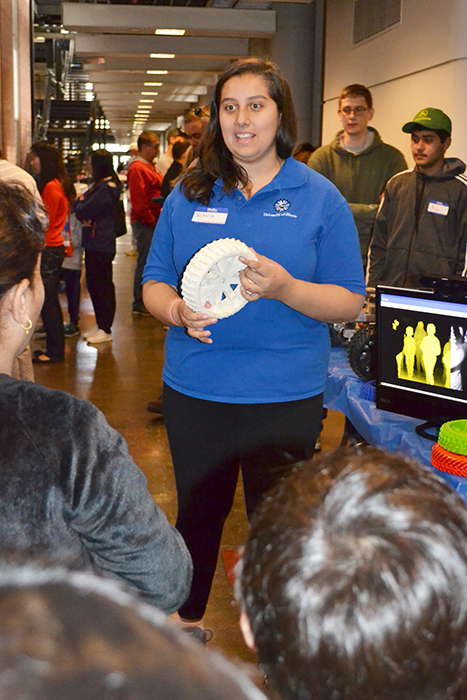 Victoria Jiron, president of Illinois Robotics in Space, shows visitors a part 3D printed for space.
Victoria Jiron, president of Illinois Robotics in Space, shows visitors a part 3D printed for space. Illinois Space Day visitors wait to receive marshmallows that have been flash frozen in liquid nitrogen.
Illinois Space Day visitors wait to receive marshmallows that have been flash frozen in liquid nitrogen.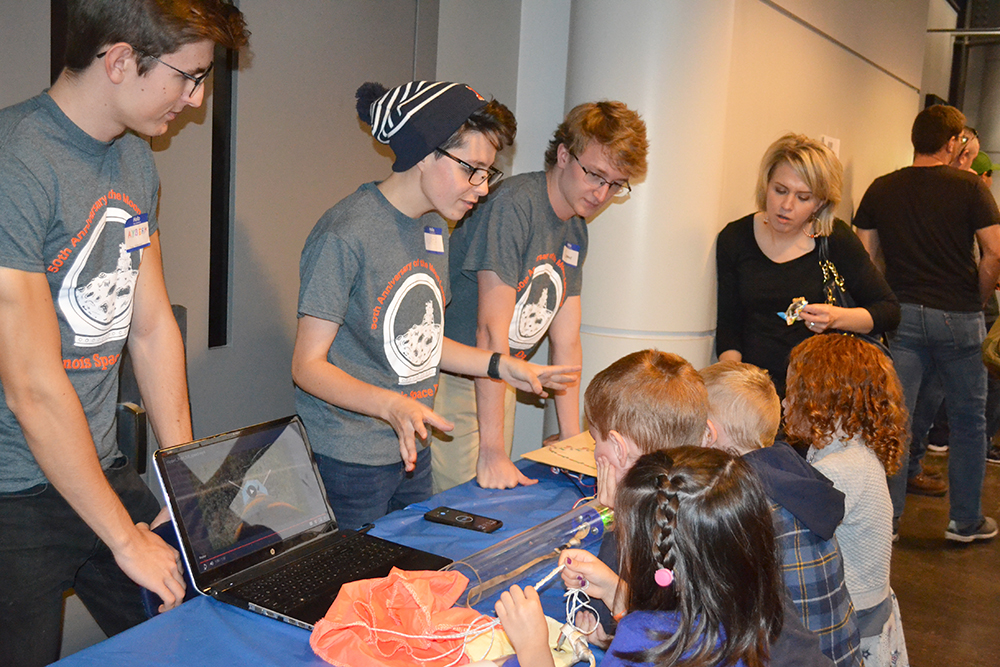 Illinos Aerospace Engineering students explain to young visitors about the parts of a rocket.
Illinos Aerospace Engineering students explain to young visitors about the parts of a rocket.












.jpg)
















